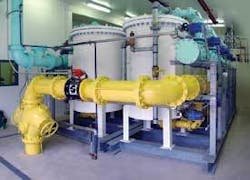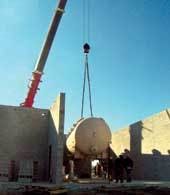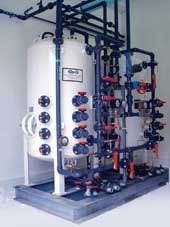by Michael Havener
Radium is a naturally occurring alkaline earth metal, and since radium is generally soluble, it can also be found in groundwater. Since radium is a known carcinogen, the U.S. EPA has established the Radionuclides Rule, which regulates the combined levels of radium 226/228 to a Maximum Contaminant Level (MCL) of 5 picoCuries per liter and Gross Alpha to 15 picoCuries per liter. While 25 isotopes have been identified, radium is typically found in groundwater as varying combinations of three isotopes: Ra224, Ra226 and Ra228. Although Ra224 decays rapidly, having a half-life of only 3.66 days, if a sample is analyzed immediately after collection, it contributes to the Gross Alpha. Of greater concern is Ra226 with a half-life of 1,599 years, and Ra228 with a half-life of 5.76 years.
Radium Treatment Methods
Radium can be removed from potable water to compliant levels using any of several methods, and working systems can be found that use co-precipitation, ion exchange or adsorption. Reverse osmosis also removes radium, but typically will generate wastewater flows of 15 to 20%.
Since radium reduction in water also results in concentrated radium in the waste, disposal of the resulting low-level radioactive waste is a central concern, and while each of the available treatment technologies has unique characteristics, treatment systems are typically selected based on a plant’s ability to dispose of waste containing concentrated radium.
Radium Removal Through Co-Precipitation With HMO
Greensand or other manganese dioxide media filters are typically used for the removal of manganese and iron, but many years ago it was observed that these filters were also capable of removing some radium. Since radium bonds readily to manganese dioxide, with the addition of Hydrous Manganese Oxide (HMO) it is possible to co-precipitate radium during manganese removal. During HMO co-precipitation, preformed manganese oxide is added to water, which is then filtered through a standard iron and manganese removal system. Radium is removed from the water as a solid when the filter is backwashed. Co-precipitation systems can employ either lime softening or hydrous manganese oxide filters. These systems provide the additional benefit of iron and manganese removal.
Systems employing co-precipitation through HMO require regular backwashing, resulting in backwash water with radium discharge. Compliant disposal of radioactive solids must be considered during system specification.
Radium Removal Through Ion Exchange
As with any contaminant removed through ion exchange, radium is adsorbed onto a resin bed. Once radium is removed from the resin through regeneration, it is concentrated in the brine. Liquid wastes from radium removal are allowed to be discharged to a sanitary sewer, provided the levels are less than federal, state and local limits. If the brine exceeds these levels, radium must be removed to compliant levels before the brine can be discharged to a sanitary sewer. This can be accomplished with the addition of an adsorption system to remove the radium from the brine, which may then be reused or discharged.
Radium Removal Through Adsorption
Radium can be removed from potable water through adsorption, and a NSF approved resin has been developed by Dow that can be used to treat brine or used directly on the raw water for radium removal. In a direct adsorption process, water passes through a resin bed where radium is adsorbed to resin. Since the radium is permanently adsorbed, no regeneration is required and there is no liquid waste discharge. Typically, several years pass before the media requires replacement, at which time spent resin is disposed as solid low level radioactive waste in accordance with all applicable regulations. Care must be taken for the monitoring of radium levels and the appropriate disposal of spent resin, as solid wastes must go to an approved low level radioactive waste disposal site.
Radium Removal Through Reverse Osmosis (RO)
Reverse osmosis can remove many inorganic contaminants very effectively, including heavy metals and radionuclides such as radium and uranium. In fact, reverse osmosis systems have demonstrated an ability to remove 87 to 98% of the radium present in drinking water. Similar elimination can be achieved for alpha particle activity and total beta and photon emitter activity. RO systems provide further benefits by removing many other contaminants. A potential serious drawback to reverse osmosis is the creation of a sometimes sizeable concentrated waste stream. RO systems typically will have a waste stream of 15 to 20%, and this waste stream will contain radium and high TDS levels. This low level radioactive waste will have to be disposed of in accordance with local and state regulations. Other factors to consider in RO-based radium removal systems are the possible need for pretreatment and the possibility of high capital and operating costs.
Summary
All the methods described in this article are capable of removing radium from potable water, and for each method radium becomes concentrated in either liquid or solid waste. Selection of an optimal removal method is typically site-specific, and the process selection centers on waste disposal issues, the presence of other contaminants, capital cost and operational cost.
About the Author:
Michael Havener, P.E. is Vice President of Water Treatment for Layne Christensen Company, which will be exhibiting at ACE ‘07. More information on radium removal or complete water treatment systems is available from the company’s Water Treatment Division, www.laynechristensen.com.






